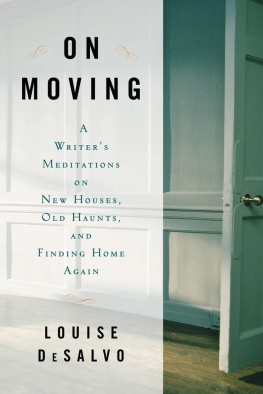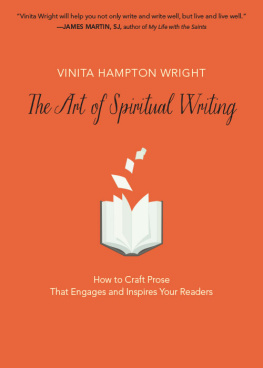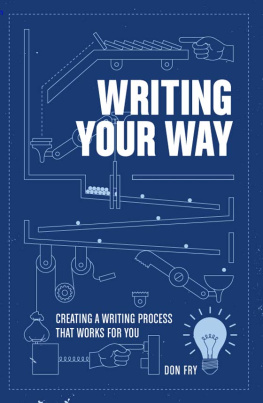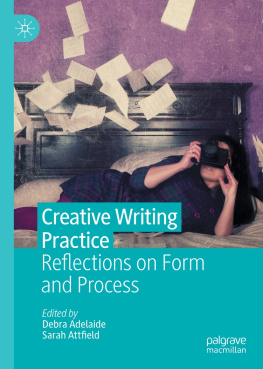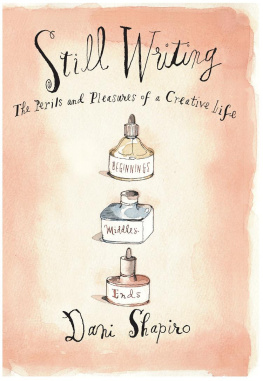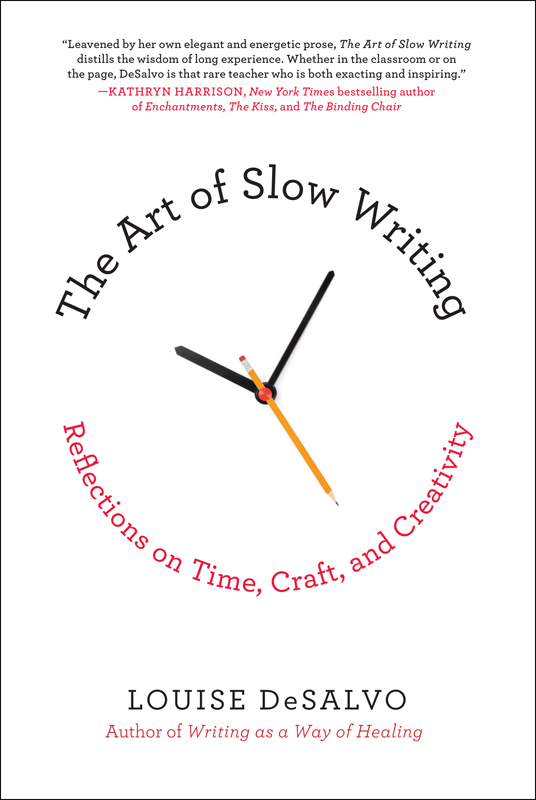Contents
Guide

The author and publisher have provided this e-book to you for your personal use only. You may not make this e-book publicly available in any way. Copyright infringement is against the law. If you believe the copy of this e-book you are reading infringes on the authors copyright, please notify the publisher at: us.macmillanusa.com/piracy.
For Ernie DeSalvo, Edvige Giunta, and Amy Jo Burns with thanks
Contents
Preface
Its late April and Im sitting in my office at Hunter College in New York City, talking to a student writer about her work in progress. Ive witnessed this writers struggle to get to the heart of her storya memoir about how her family was affected by her fathers experience as a first responder to the Twin Towers tragedy. She tells me shed like to finish her book by the end of the summer. She has a fine first draft in hand. But this is a big subject; its significance cant be plumbed quickly. My job, now, is to help her realize itll take time to achieve the complexity she desires. On the bulletin board behind my desk, Ive posted lines from the poem, A Lazy Thought, by Eve Merriam: It takes a lot / Of slow / To grow. And by the end of our meeting, she understands that, yes, her work is too significant to rush.
Beginningand even accomplishedwriters often expect to complete an essay in a few weeks, a book in a year. As Roxane Gay has written in Salon , we have a cultural obsession with genius. Yet the best writing grows by accretion, over time. As John Updike said, I try to be a regular sort of fellowmuch like a dentist drilling his teeth every morningexcept Sunday. Taking time prevents us from writing knee-jerk responses to challenging material. It encourages us to reflect upon, and express, the complexity of our subjects. It allows us to understand that creating fine work can only be achieved by a slow, consistent dedication to our craft.
The Art of Slow Writing: Reflections on Time, Craft, and Creativity is based not upon how I believe writers should work, and not upon how I work, but upon decades of research into the writing process and the work habits of real writers. If we understand the writing process, learn how real writers work, and use that information to develop our unique identity as writers, well transform our writing lives. In reading the letters, journals, and interviews of well-known writers, I learned that virtually all described the process I refer to here as slow writing, one that paradoxically allows us to take risks and make intuitive leaps in our work.
In The Art of Slow Writing, youll find slow writing anecdotes from writers of classic works like D. H. Lawrence, Virginia Woolf, Henry Miller, and John Steinbeck. But I also include reflections from contemporary writersJo Ann Beard, Michael Chabon, Junot Daz, Jeffrey Eugenides, Mary Karr, Maxine Hong Kingston, Ian McEwan, and Salman Rushdie, among others.
The Art of Slow Writing begins with an introduction articulating how I developed the slow writing concept. Part One, Getting Ready to Write, explores the beginning stages of the writing process, how we find our authentic subjects, how we discover our way of working. Part Two, A Writers Apprenticeship, examines how long it takes us to learn our craft or develop a new project. Part Three, Challenges and Successes, addresses learning patience, overcoming a fear of failure, and cultivating determination. Part Four, Writers at Rest, rethinks writing blocks as moments when we step back and regroup before resuming our work; it discusses, too, writing when were ill. Part Five, Building a Book, Finishing a Book, illuminates the hurdles we encounter and surmount to successfully complete our work. An epilogue suggests how we can begin the process of writing our next work.
The reflections in The Art of Slow Writing are an invitation for us to think about specific techniques we can use to enter the slow writing life; find ways to deal with the emotional pitfallsfear, anxiety, judgment, self-doubtthat inevitably accompany our work; delve into what it means to live a healthy and productive creative life; and celebrate our tenacity and our accomplishments. In our rush-rush world, if we allow ourselves to slow down our lives and our writing process, well discover that well connector reconnectwith the wellspring of our most profound work.
Introduction
The Art of Slow Writing
I love visiting writers houses. I imagine a writer sitting at a desk; taking time to craft each sentence of a work in progress; living the unhurried, unharried writers life I desire, the one I try (sometimes successfully, sometimes not) to enact myself.
When my husband and I planned a trip to Verona, Italy, we decided to also journey to Gargnano on Lake Garda to visit the house where D. H. Lawrence lived while he revised Sons and Lovers (1913). I was researching an essay about the impact of the places Lawrence lived upon his work. In exile from England, writing at a desk positioned so he could view the changing light on Monte Baldo across the lake, Lawrence re-created his childhood in Eastwood, Nottinghamshire. He described his collier father and his grueling work, his proper mother who wanted a better life for her children, the violent arguments between his parents. He wrote about his early, unsuccessful efforts at love, his struggle to free himself from his mothers dominion, his response to her death, and how he became a writer.
On Lake Garda, Lawrence went back and transformed his manuscript Paul Morel into Sons and Lovers . Hed begun the work in the autumn of 1910; the draft he produced on Lake Garda was his fourththe novel took two years and four drafts to complete. In this revision, Lawrence transformed the work from a rather straightforward autobiographical novel into a study of a young mans growing understanding of his own troubled sexuality. Lawrence wrote his friend Edward Garnett that in Gargnano he made [ Sons and Lovers ] patiently, out of sweat as well as blood.
As I planned our trip, I was beginning to think about the process of slow writing. Visiting Lawrences house would be a pilgrimage, a reminder of my own desire to work as patiently as Lawrence had. I was in the midst of writing a chapter for a book in progress about my parents lives during World War II, describing how they found and decorated an apartment near the docks in Hoboken, New Jersey. The United States hadnt yet entered the war. Still, my parents knew war was imminent and that my father would be called back into service because hed been in the navy before and was an expert airplane machinist.
I knew how much that apartment meant to them, and how hard they worked to make it beautiful. But I suspected there was far more to the story. Writing about my fathers wartime absence, the terrible carnage of that war, and how the war changed him was difficult. I knew there was no way to rush this. Each time I worked, Id have high expectationsId want to write four, five, maybe six pages. After all the time Id spent researching and writing preliminary drafts, I expected myself to complete the chapter quickly and well.
Id noticed how my students at Hunter College often told me they wanted to finish their memoirs in a year or two, a condition I jokingly referred to as terminal hurriedness. Whats the rush? Id ask, even as I was pushing myself, too.
After Id published Writing as a Way of Healing (1999), Id communicated with scores of writers whod begun important projects. They also complained about how long their works were taking. To help themand myselfunderstand how long it took to complete a work, Id begun collecting anecdotes about how slowly many famous writers and artists worked. Salman Rushdie, in his memoir, Joseph Anton , described that it took him thirteen years to understand that his identity as a writer was that of a migrant who ended up in a place that was not the place where he began. After finding the right voice, Rushdie worked for three more years to complete his first novel, the Booker Prizewinning Midnights Children (1981). Vincent van Gogh also took long to perfect his talent; he had no talent for drawinghis early work was horrible; but he persisted: If he couldnt do it, he tried it 50 more times.


